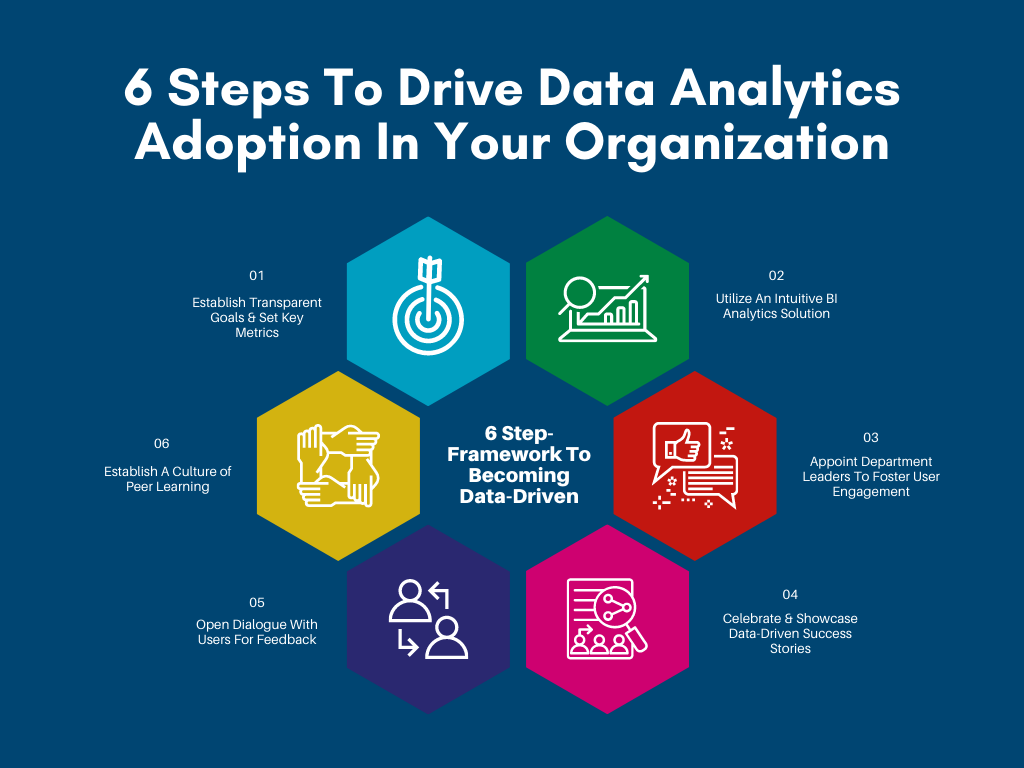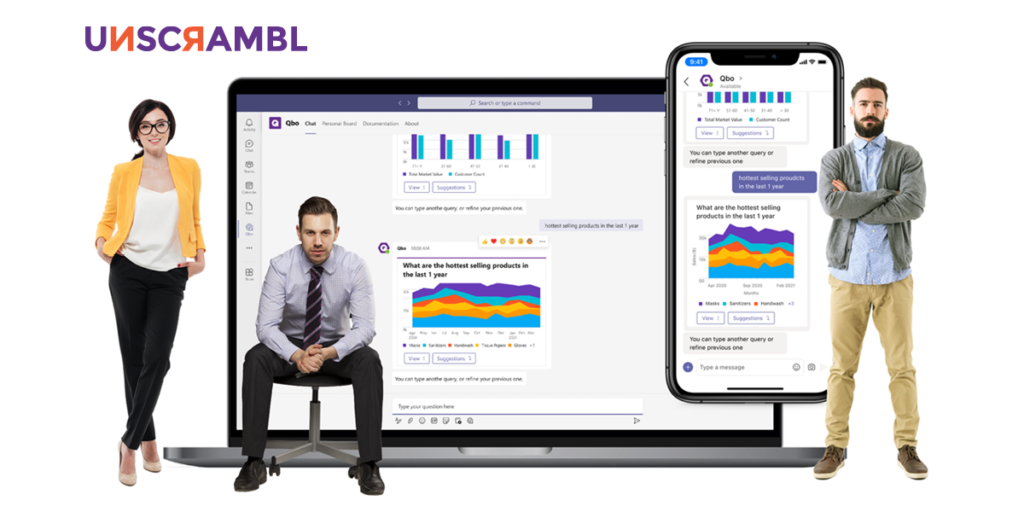 6 Minutes
6 Minutes

How To Drive Data Analytics Adoption In Your Company: 6 Steps To Get Started
While data is key to transforming organizations and the fuel to unleash innovation, many companies still aren’t consistently or effectively making data-driven decisions.
From an increase in analytics tools options to self-service business intelligence (BI) solutions, technology might have advanced but many organizations are not still data-driven with legacy mindsets and habits that result in disparate decision making.
According to Gartner’s 2019 analytics and BI Magic Quadrant survey, modern analytics and BI adoption rate stands at only 35%. And at the heart of this challenge is the need to drive data analytics adoption across business units, users and leaders to help develop an organization’s analytical muscles.
In fact, the median BI software penetration rate is only 17% across an organization, highlighting a real challenge that companies face as they strive to create a data-driven culture.
In this article, we will take you through why data analytics adoption is a challenge and how companies can take actionable steps to foster a culture that embraces it.
The Key Challenges Of Data Analytics Adoption
It is an all too familiar scenario where a new self-service analytics platform with beautiful dashboards is first introduced. Users might initially give it a try for novelty’s sake but the usage rate quickly drops and CIOs are left scratching their heads wondering what went wrong.
In a survey, it was discovered that the three biggest problems companies face that cause a low adoption rate are a lack of analytical knowledge, trust in data and a lack of technical knowledge.
Here’s a closer look at the challenges that organizations face in their efforts to drive adoption:
1) The analytics tool is too challenging and time-consuming to use
Effective data analytics adoption can only be realized if using the tool is as easy as possible.
Adding complexity to the lives of users isn’t ideal where most employees are already stretched for time to achieve their own business targets.
While teams of data analysts and scientists might have little problem becoming proficient quickly with the analytics tool, the majority of users (from the boardroom to the store-front) will likely feel overwhelmed and abandon it the first chance they get.
2) Business leaders and users aren’t clear about the metrics that matter to track
Data analytics is a means to an end and without clear goals and the accompanying metrics to measure and work towards, users won’t be able to effectively utilize the analytical tool.
The key question of ‘What do you want the data to do for you’ will be left answered with users tinkering with the tool to populate their dashboards with ‘feel good’ metrics and statistics, and leaving users wondering whether they can actually trust the numbers they are seeing, or whether things have been ‘massaged’ to look good.
This inadequate clarity on business outcomes will inevitably lead to users defaulting to their previous methods of decision-making.
3) A lack of data interpretation and analytical skills
While a company might have a desire to really utilise their analytics tool to make better data-driven decisions, data literacy is still a big issue in many organizations.
Teams of data and IT experts are expensive to hire and even when they are present, there is still a lag-time for non-technical users to articulate their data needs to these teams.
Even with modern BI solutions’ ability to deliver insights on demand, understanding and effectively analyzing the results is still a hurdle that hinders the greater adoption of analytical tools.
This is such a recognizable problem that according to Gartner – by 2020, 80% of organizations will initiate the development of their employees in data literacy.
Companies that solve the adoption challenge will be able to truly push towards becoming a data-driven organization and reap the benefits.
In fact, data-driven organizations are 23 times more effective in acquiring customers and enjoy an average of 8% boost in revenues and a 10% reduction in their costs.
While the road to higher data analytics adoption might be rocky, there is a proven path to success that every organization can embark on.
To help organizations better chart their way to data adoption success, we have created a 6-step roadmap you can follow to get started immediately.
6 Steps To Take To Drive Data Analytics Adoption In Your Organization
Effective adoption requires a holistic approach that involves bringing together the best analytical tools as well as shifting habits and mindsets in an organization.
Let’s dive deeper into the steps to create an environment in your company that facilitates the widespread use of data for decision-making, big or small.
1) Establish Transparent Goals & Set Key Metrics
Getting started with data analytics can be difficult if there is no unified direction to look to.
Business leaders across an organization can take the initiative to set departmental goals that all contribute towards achieving the main goal of the entire company – which could be anything from higher revenue, higher customer retention to lower employee turnover.
By being transparent and upfront with these goals, users will then be able to define and set the key metrics that matter to them. Not only will employees have a clearer picture of what to measure, there will also be a greater sense of accountability.
For example, when the goal for the customer department is the customer retention rate, key metrics such as average resolution time, average reply time and ticket backlog can be tracked with data analytics.
This allows for the right questions to be asked to gain insights that matter.
2) Utilize An Intuitive BI Analytics Solution
Many organizations have disparate data that are siloed away, making it necessary for business leaders to approach data experts to retrieve and analyze the data.
That means delays that cause insights to be outdated plus a clear and present hassle that disincentivizes users to even think of utilizing data.
In addition, while there are many self-service BI solutions in the market, they still require users to understand the right search strings to type in as well as have some analytical knowledge to ask the right questions.
Thankfully, by using the right business intelligence solution powered by conversational analytics, users will be able to ask questions directly to their data as they would in a normal conversation.
That means unlocking true data democratization throughout the organization where any user, from the boardroom to the sales floor, will be able to independently gain insights on demand.
3) Appoint Department Leaders To Foster User Engagement
While buy-in from the top leadership is necessary to highlight the importance of data analytics, long-term adoption will have to come from fostering user engagement on a daily basis.
By appointing department leaders to foster user engagement, curriculums and training can be tailored to each individual business unit’s needs instead of holding a centralized training session that is neither productive nor effective.
Department leaders will be able to develop their own training materials, case studies and data analytics protocols to help ensure users of the analytics platform are utilizing it effectively and efficiently.
4) Celebrate & Showcase Data-Driven Success Stories
Fostering a culture of data analytics use means proving to users and stakeholders that the insights derived from its usage are effective.
A great way to do this is to celebrate successful decisions that came from data-driven insights.
This isn’t just restricted to decisions that improve key KPIs such as revenue, sales or leads generated, but also for decisions made that affect employee culture – such as work-life balance and employee engagement.
Leaders can follow a structure to conduct these sessions in a show-and-tell manner that invites teams involved in the decision-making process to take everyone through:
- The challenge they faced
- How they utilized the data analytics platform
- The action taken from the insights derived
This motivates teams to learn and establish a framework for their future interactions with their BI platform.
5) Open Dialogue With Users For Feedback
While continuous training is key to educate and update teams on the best practices of utilizing the analytics platform, this is best done through understanding the challenges faced by the actual users themselves.
By holding open dialogue and regular discussions, business leaders can get data experts along for regular sharing sessions to understand the difficulties faced and identify common questions that arise.
This will allow for better training sessions to be conducted as well as resources (such as training videos or blog posts) to be created that can be shared throughout the organization.
6) Establish A Culture Of Peer Learning
While having data experts leading training sessions is one way to continuously engage analytics users, it is better and more cost-efficient to let users themselves teach and learn from each other.
Learning from those around you is nothing new, around 55% of workers first turn to their peers when it comes to learning a new skill.
By enabling peer learning, organizations will be able to allow users to learn in an environment where they can take bigger risks and ask extensive questions without a sense of being judged by their superiors.
Here are three guidelines to remember when establishing a peer learning environment:
- Focus on real business situations and challenges to stay highly relevant
- Encourage cross-departmental learning and collaboration to gain varied insights and perspectives
- Set guidelines for feedback to ensure only polite and constructive criticism is given

Drive Greater Data Analytics Adoption For Your Organization Today
Every company desires to make better data-driven decisions and that will require first fostering widespread data analytics adoption throughout the organization.
By integrating the right analytics solution together with the best practices highlighted in this article, you’ll be able to easily establish a culture where teams prize the use of data to drive their everyday work and decision making.
At Unscrambl, we have Qbo, a business intelligence solution powered by conversational analytics. This allows users throughout your organization to gain immediate insights on demand without going through a steep learning curve – they just need to ask questions!
Embark on a free 14-day trial today and see for yourself how easy driving data analytics adoption can be.



